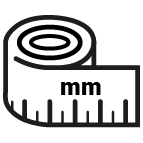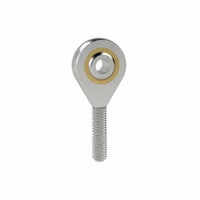
Plastic Polymer swivel eye rose joint rod ends female thread
Material
Housing: Black Plastic (Igumid G)
Spherical bearing: Iglidur w300
From £5.94 £4.95
Please Login to see select CAD
Mechanical Properties
Maintenance-free plastic bearing components offer a notably high load capacity at standard ambient temperatures while significantly lighter than their steel counterparts. These plastic bearings excel in dampening vibrations due to their polymer material, which absorbs vibrations differently from steel. However, it's crucial to be mindful of their specific characteristics, including temperature sensitivity and long-term stress behaviour. To ensure optimal performance, practical load capacity tests are advisable, especially when these rod ends will be exposed to continuous heavy loads and elevated temperatures.
Superior Corrosion Resistance
Plastic polymer rod ends are renowned for their remarkable corrosion resistance, making them ideal for challenging environments. They excel in damp conditions and remain resilient to mild acids and alkaline substances. Moreover, their ability to repel dirt and dust sets them apart.
Durable Housing Material
The housing is constructed from an incredibly tough, long-fiber-reinforced polymer. It can withstand temperatures ranging from -40 °C to +90 °C over extended periods.
Optimised Spherical Bearings
In standard spherical bearings, the spherical ball is crafted from iglide® L280 material, known for its exceptional dry operation performance, with minimal friction coefficients and a remarkable resistance to stick-slip. This quality is especially crucial for low loads and slow movements.
- Maintenance-free and cost-effective
- No need for lubrication
- Heavy-duty construction
- Exceptional durability under varying loads
- Misalignment error compensation
- Edge load compensation
- Resistant to dirt, dust, and lint
- Corrosion and chemical resistance
- Suitable for use in liquid media
- High vibration damping
- Applicable for rotating, oscillating, and linear movements
- Inner rings set in housings with minimal clearance
- Lightweight design
Typical Applications
These rod end bearings are versatile and find applications in various industries, including:
- Bicycle manufacturing
- Plant construction
- Packaging
- Offshore projects
When to Use These Plastic Rod End Bearings?
Consider using plastic rod end bearings when:
- You need to save weight
- Rotating, oscillating, or linear movements are required
- High-frequency oscillations or vibrations occur
- Low-noise operation is essential
- You require an electrically insulating component
- Corrosion resistance is crucial
- You need heavy-duty performance
- Combining with pneumatic cylinders and gas struts
- Chemical resistance is necessary
When Not to Use Plastic Rod End Bearings?
Avoid using plastic rod end bearings when:
- Operating temperatures exceed +90 °C
- Rotation speeds higher than 0.5 m/s are required
- Very high tensile and axial forces are expected
- Applications involve hydraulic cylinders
Tolerances
Plastic-bearing elements are adaptable to different tolerances depending on the application. They come with a generous bearing clearance in the standard product, ensuring reliable operation even at high peripheral speeds. The inner ring's bore adheres to a standard tolerance range of E10, while shafts should meet recommended tolerances of h6 and h9. Always verify the inner diameter for precision.
Sliding Friction and Speed Coefficients
One key advantage of maintenance-free plastic spherical bearings is their ability to accommodate rapid rotary movements. This unique plastic/steel-plan bearing arrangement enables high-speed operation even in dry conditions. When factoring in radial loads, maximum surface speeds of up to 0.5 m/s in rotation can be achieved. Angular movements of the spherical bearings occur at the spherical ball's outer diameter, also allowing for linear shaft movements.
Chemical Resistance
Both the spherical ball and the housing bearings exhibit resistance to weak alkalines, weak acids and fuels.
| MATERIAL | Plastic |
|---|---|
| Unit Type | Metric |
| Stock Guaranteed | No |







